It can’t be denied that some of the most beautiful lakes in the United States lie in California. Among the many breathtaking outdoor settings around the state, these lovely lakes stand out with unique natural charms. Numerous freshwater lakes and reservoirs in California offer various recreational options, including boating and swimming. The best lakes for a holiday break are located in resort areas of the state.
The northern part of the state is within easy reach of stunning bodies of water, from the world-renowned Lake Tahoe to nearby wildlife refuges like Tule Lake. The lakes of California provide a wide range of purposes that are advantageous to both people and the surrounding animals. But which lakes are the biggest in Northern California? This article will explore the 12 biggest lakes in Northern California and other interesting facts.
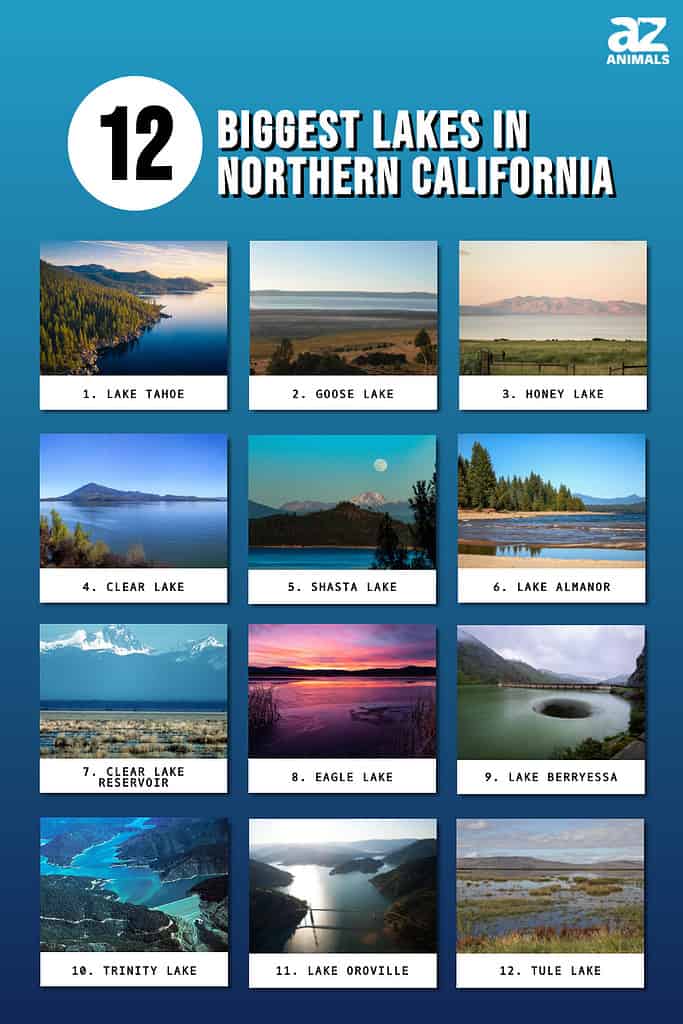
Background On Northern California
Northern California, locally referred to as NorCal, spans the 48 northernmost counties of the state. The San Francisco Bay Area, which includes the cities of Oakland, San Jose, and San Francisco, the Redding, California area south of the Cascade Range, the Metropolitan Fresno area, and the Greater Sacramento area are the primary population centers in the region. Along with the majority of the Sierra Nevada, Yosemite Valley, a portion of Lake Tahoe, Mount Shasta, and the majority of the Central Valley, Northern California is also home to redwood forests.
The 12 Biggest Lakes in Northern California
12. Tule Lake
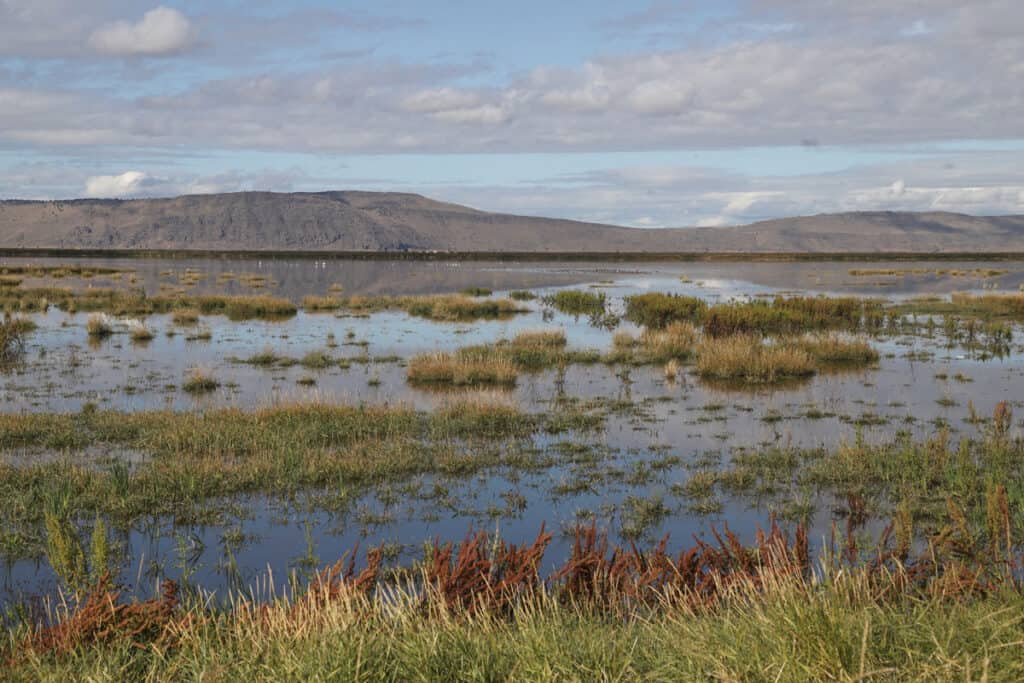
Tule Lake is only one of 20 prehistoric lakes that have been around for more than a million years.
©iStock.com/Nancy Strohm
Tule Lake measures 20.31 sq mi, holding the Klamath Project and the Tule Lake National Wildlife Refuge. Water supplies from The Klamath Project have assisted in saving waterfowl and other lake-dwelling animals. Along the border with Oregon, the lake is located in northeastern Siskiyou County and northwest Modoc County in California. It is one of only 20 prehistoric lakes that have been around for more than a million years. On the other hand, current severe drought circumstances have put this in grave danger.
11. Lake Oroville

Lake Oroville is a sizable reservoir with a surface area of 25 square miles.
©iStock.com/OwensImaging
Located in the Lake Oroville State Recreation Size, Lake Oroville is a sizable reservoir with a surface area of 25 square miles. Lake Oroville is a cornerstone resource within the California State Water Project, assisting in preventing saline intrusion into the Sacramento-San Joaquin Delta, preserving fish and wildlife by retaining water, managing flood, recreation, and freshwater discharges.
The Feather River was impounded by the Oroville Dam in northern California’s Butte County, creating Lake Oroville. The lake is a well-known bass fishing spot in the country, and coho salmon are supplied from the Feather River Fish Hatchery.
10. Trinity Lake

Trinity Lake is a man-made lake on the Trinity River.
©Blake, Tupper Ansel, U.S. Fish and Wildlife Service /This work has been released into the public domain by its author, Blake, Tupper Ansel, U.S. Fish and Wildlife Service. This applies worldwide. In some countries this may not be legally possible; if so: Blake, Tupper Ansel, U.S. Fish and Wildlife Service grants anyone the right to use this work for any purpose, without any conditions, unless such conditions are required by law. – License
Northern California’s largest lakes list includes Trinity Lake in Trinity County, with a surface size of 25.8 sq mi. It is a man-made lake on the Trinity River made possible by the Trinity Dam and used for irrigation and hydroelectric generation in Trinity County, California.
Trinity Lake has fantastic water skiing options and a lot of little arms and crystalline inlets. The lake is one of California’s biggest reservoirs, with a 2,447,650 acre-foot capacity.
9. Lake Berryessa

Lake Berryessa is the largest lake in California’s Napa County.
©iStock.com/Chris LaBasco
The largest lake in California’s Napa County is Lake Berryessa, which has a surface area of 32.3 square miles with a shoreline that extends for about 165 miles. This reservoir has been supplying water and hydroelectricity to the San Francisco Bay Area’s North Bay since the early 1960s.
Lake Berryessa has both warm-water and cold-water fish species, making fishing there productive all year long. Fish of all kinds can be found in Lake Berryessa, including landlocked salmon and sunfish. Channel catfish, pikeminnow, bluegill, crappie, brown, brook, and rainbow trout, Kokanee and Chinook salmon, largemouth, smallmouth, and spotted bass are among the fish that may be found at Lake Berryessa.
8. Eagle Lake
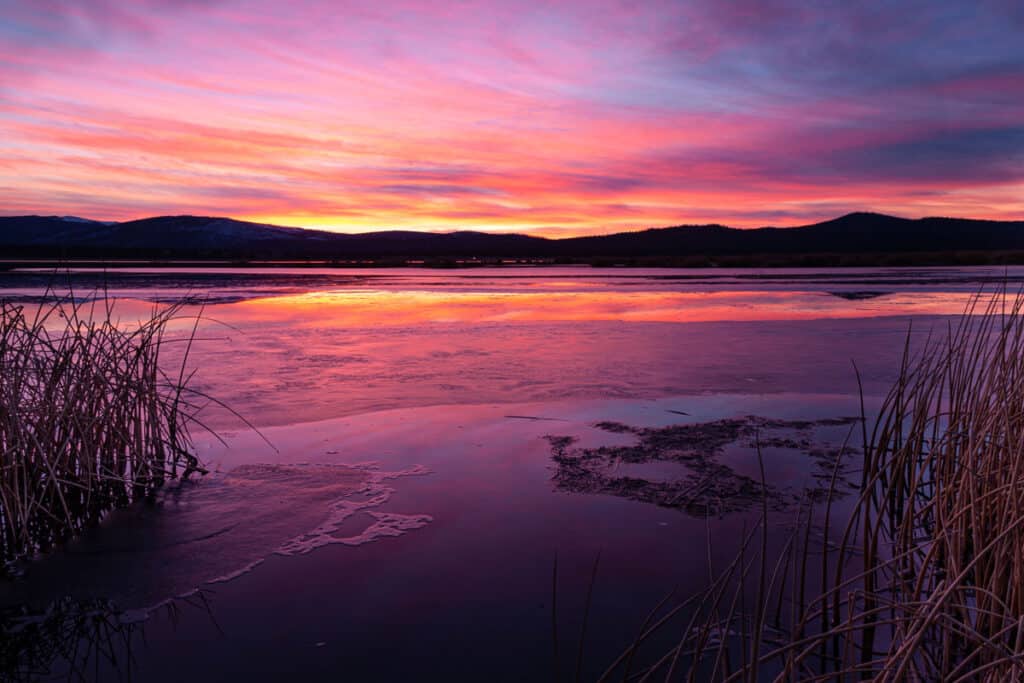
Eagle Lake is an endorheic alkaline lake.
©Micheal Lee/Shutterstock.com
In Lassen County, California, there is an endorheic alkaline lake called Eagle Lake. Following Clear Lake, it is the second-largest natural lake in the state, with a surface size of 37.5 square miles. It is located wholly within California and is home to osprey and bald eagles, hence its name. The lake is one of the highest in the country, elevated to a height of 5,098 feet above sea level. Additionally, the native Eagle Lake trout are solely supported by the watershed of Eagle Lake.
7. Clear Lake Reservoir
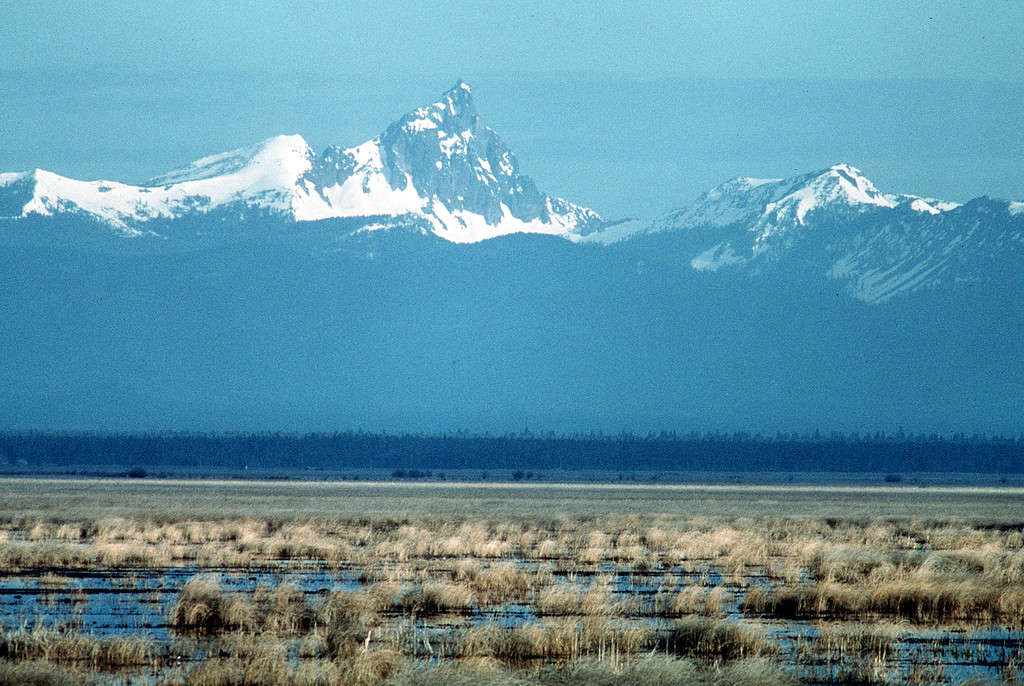
This reservoir is part of the Modoc National Forest and the Klamath Basin, shown here.
©David Menke, Public domain – License
An artificial lake called Clear Lake Reservoir is located in northeastern Modoc County, California. It measures 40.23 sq mi in size and is a part of the Modoc National Forest and the Klamath Basin. At full capacity, the dam’s reservoir is only an average depth of about 20 feet, which causes an extremely high rate of evaporation.
6. Lake Almanor
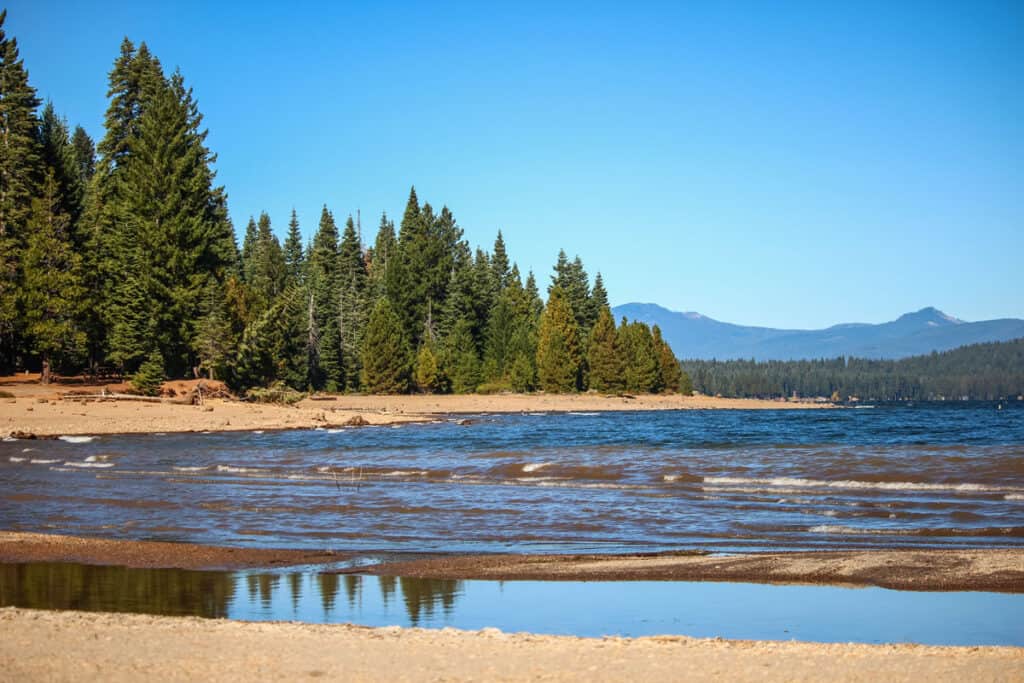
Lake Almanor is the widest lake in California.
©iStock.com/Laurens Verhoeven
A sizable reservoir called Lake Almanor is located in northern California’s Plumas County’s northwest. Despite having a surface area of only 44 sq mi (113.3 sq km), Lake Almanor is the widest lake in the state. Lake Almanor offers many chances for recreation. The reservoir can hold 1,308,000 acre-feet (1.613109 m3) of water and can get as deep as 90 feet (its deepest point). This lake offers a variety of well-liked outdoor pursuits, including camping, hiking, and fishing, in addition to hydroelectric power generation.
5. Shasta Lake
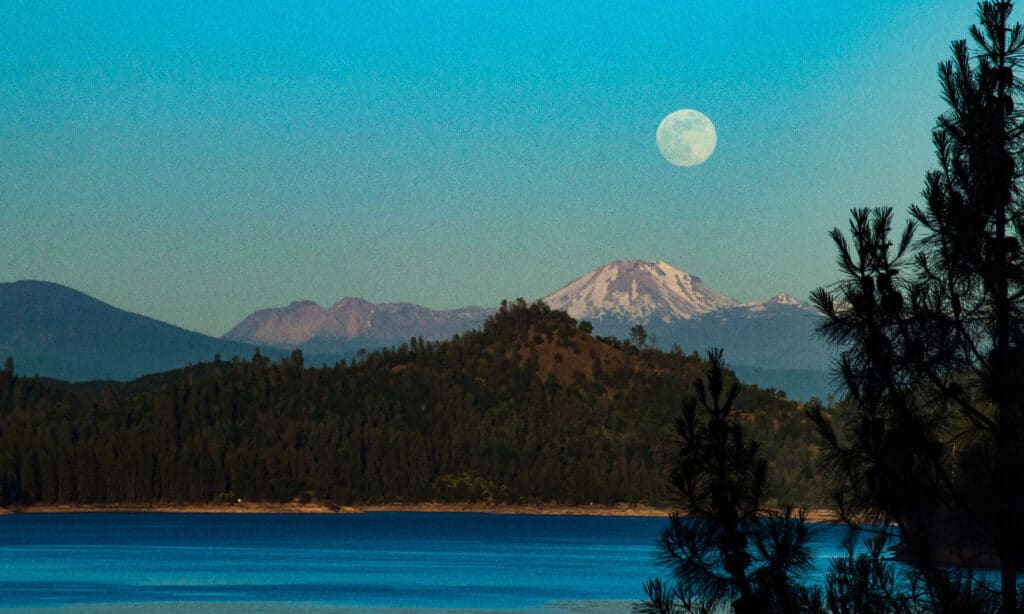
Lake Shasta is California’s largest artificial lake.
©iStock.com/Jerry Hamblen
California’s largest artificial lake, Lake Shasta, has a surface size of 121.4 square kilometers, or 47 square miles. The Shasta Reservoir, which is located above the Sacramento River, is used to generate hydroelectricity. Since Shasta Dam (7th largest dam in the US) impounded the Sacramento River, the reservoir started to store water in 1944. A crucial piece of the Central Valley Project, Shasta Lake controls flooding in the Sacramento Valley downstream of the dam.
4. Clear Lake

The oldest lake in North America is Clear Lake.
©iStock.com/Michael Overstreet
Clear Lake is one of California’s largest lakes, with a total surface area of 68 square miles or 180 square kilometers. This largest naturally-occurring freshwater lake wholly inside California’s borders lies between Napa County and San Francisco. Developed some 2.5 million years ago, it is the oldest lake in North America.
Large numbers of largemouth bass, bluegill, carp, crappie, and catfish can be found in Clear Lake. The Clear Lake basin is home to various animals, including fish and year-round populations of pelicans, ducks, egrets, blue herons, ospreys, and bald eagles. Large numbers of mountain lions, deer, bears, raccoons, and other animals also live in the lake’s basin.
3. Honey Lake

The third largest lake in Northern California is Honey Lake.
©Spencer Gentz/Shutterstock.com
Honey Lake is an endorheic sink with a surface size of 86 sq mi (220 sq km), located in the Honey Lake Valley. It is situated in northeastern California, close to the Nevada border. The lake shrinks to 3,000 acres throughout the summer due to evaporation, leaving a dry lake. On Honey Lake, people enjoy hiking, bird watching, warm-water fishing, waterfowl hunting, camping, and picnicking.
2. Goose Lake

The second biggest lake in Northern California is Goose Lake.
©Jeffrey Yoshimi / Creative Commons – License
Goose Lake, which has a surface size of 147 square miles or 380.7 square kilometers, is the third-largest lake in the US state of California. The enormous salt lake is situated in the Goose Lake Valley, not far from the Oregon-California state line.
The lake’s northern and southern halves are located in Modoc County, California, and Lake County, Oregon. Most of the property in the region surrounding the lake valley is privately owned agricultural land, though. It is a pluvial lake created during the Pleistocene era by precipitation and melting glaciers.
1. Lake Tahoe
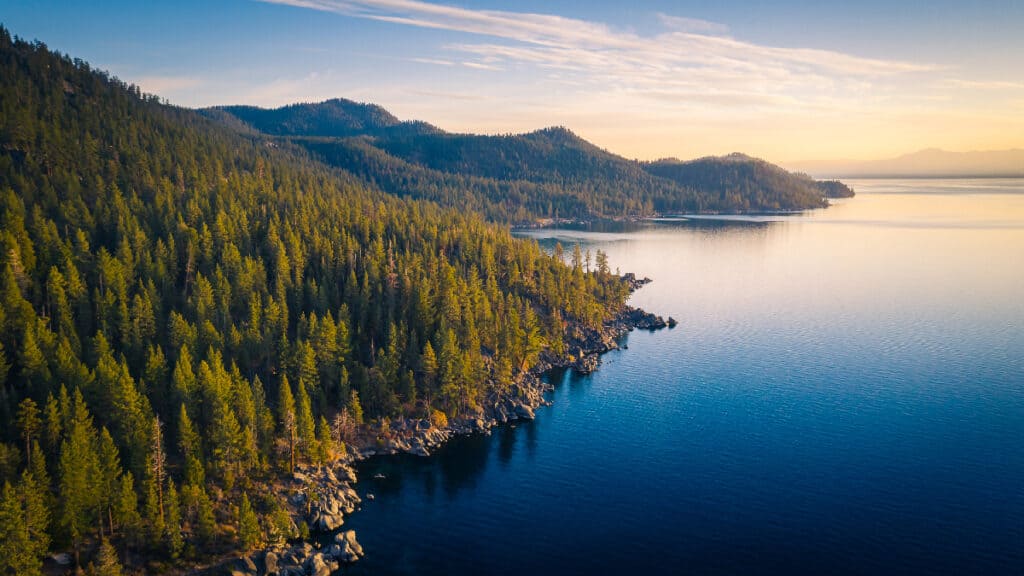
The biggest lake in Northern California is Lake Tahoe.
©iStock.com/heyengel
Lake Tahoe is the second-biggest lake in California by surface area, covering a total of 191.58 sq mi or 496.2 sq km, although it is the largest freshwater lake in terms of water volume. As one of the deepest lakes in both the United States and North America, Lake Tahoe is well-known throughout the country.
In addition to these rankings, Lake Tahoe also appears on the list of the biggest lakes in the United States due to the enormous amount of water it can hold, with a volume of 36.15 cubic miles or 150.7 cubic kilometers. Lake Tahoe is located in the Sierra Nevada, straddling the state lines of Nevada and California. The Californian lake is also renowned for having water that is 99.994% pure, which is almost as pure as distilled water, with 99.998% purity.
Special Mention:
Tulare Lake
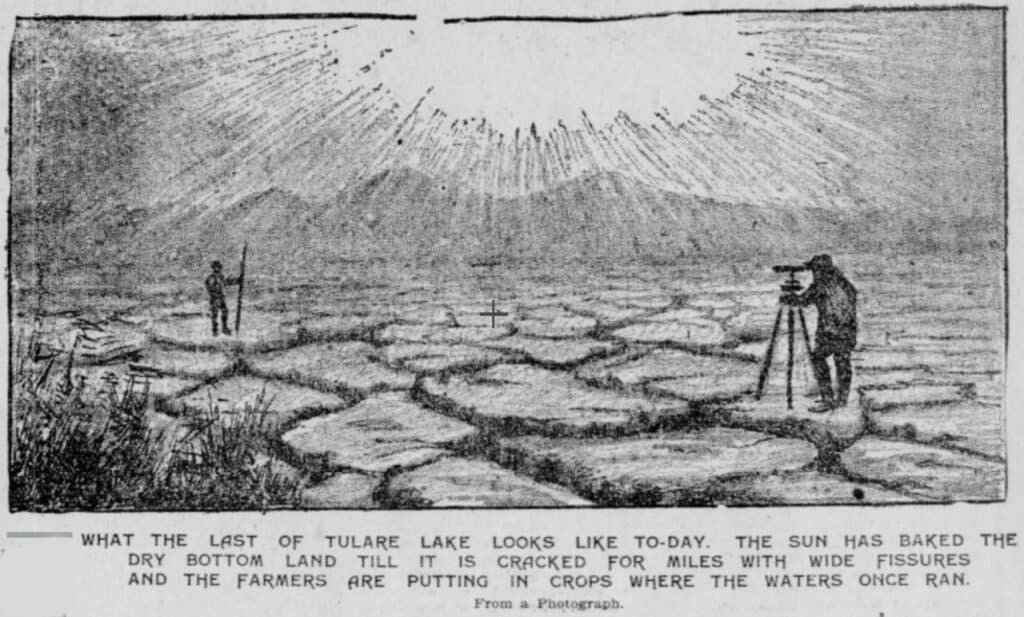
Tulare Lake was formerly the largest freshwater lake west of the Great Lakes.
©Originally published in the San Francisco Call, Volume 84, Number 75, p. 19. 14 August 1898. Hosted by California Digital Newspaper Collection, Center for Bibliographic Studies and Research, University of California, Riverside, <http://cdnc.ucr.edu> / This work is in the public domain in the United States because it was published (or registered with the U.S. Copyright Office) before January 1, 1927.
With a surface area of 690 square miles, Tulare Lake should be placed in the first spot as the largest lake in Northern California. However, the lake’s supposed vast watershed is now a dry bed. Still, it deserves to be mentioned on this list. Tulare Lake is a freshwater dry lake in California’s southern San Joaquin Valley, containing residual wetlands and marshes.
Tulare Lake’s size shifted with the quantity of precipitation and snowfall. It was formerly the largest freshwater lake west of the Great Lakes, the second-biggest freshwater lake entirely within the United States, and the largest lake west of the Mississippi River. Next to Iliamna Lake in Alaska, Lake Tulare would have been the ninth-largest lake in the entire country if it hadn’t vanished.
Discover how Tulare Lake vanished here.
Summary of The 12 Biggest Lakes in Northern California
| Rank | Lake | Location |
|---|---|---|
| 1 | Lake Tahoe | El Dorado County |
| 2 | Goose Lake | Goose Lake |
| 3 | Honey Lake | Lassen County |
| 4 | Clear Lake | Lake County |
| 5 | Shasta Lake | Shasta County |
| 6 | Lake Almanor | Modoc County |
| 7 | Clear Lake Reservoir | Modoc County |
| 8 | Eagle Lake | Lassen County |
| 9 | Lake Berryessa | Napa County |
| 10 | Trinity Lake | Trinity County |
| 11 | Lake Oroville | Butte County |
| 12 | Tule Lake | Siskiyou County |
The photo featured at the top of this post is © topseller/Shutterstock.com
Thank you for reading! Have some feedback for us? Contact the AZ Animals editorial team.







